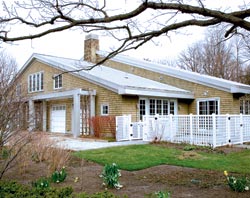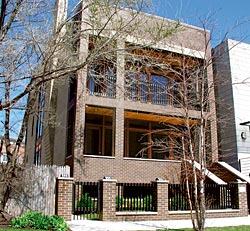Send tips about high-end home sales to dennis@rodkin.com.
A Peak from the Past
Local architect drew inspiration from a McKim, Mead & White mansion

Photograph: Chris Guillen |
|
Winnetka
List price: $3.195 million Sale price: $3.15 million |
Although just eight years old, this distinctive double-stepped gable house in the rarefied Indian Hill Club in Winnetka got its third owner in February.
The architect Margaret McCurry designed the 12-room, five-bedroom house in the late 1990s for the original owners, who wanted something historical but not overly grand. She modeled it in part on the W. G. Low House, a Rhode Island mansion designed by McKim, Mead & White in 1887.
The seller, John Rau-who formerly ran Chicago Title & Trust and now heads the Miami Corporation, a Chicago-based holding company-bought the house in 2003, when he was a single father of three. "As soon as I walked in, I knew this was the place," he says, citing the home's exquisite woodwork and its first-floor master bedroom. "When my kids weren't home, I could live on [only] the first floor," he says.
Rau's last child has finished up at New Trier Township High School, and Rau has remarried and moved downtown. His agent, Patricia Lutton of Koenig & Strey GMAC, says the buyer-who was not identified in public records-snapped it up before it was officially on the market, drawn by many of the same features Rau had liked.
A Bright Idea
Well-placed light wells and an open layout keep house out of the dark "even at night"

Photograph: Rob Goodwin |
|
Wicker Park
List price: $2.549 million Sale price: $2.25 million |
Orderly and sleek, this house is one of three visually striking contemporary homes on a semi-hidden cul-de-sac in Wicker Park. Behind them runs a vacated rail line that activists hope to convert into an elevated bike path and garden-which would further enhance the setting of this distinctly urban house.
Designed by David Sundry, who also created the plans for the two neighboring homes, this house was built in 2002 by Tony Zaskowski as his own residence; he is a developer and real-estate agent with Property Consultants. The house has five bedrooms, four full baths and two partials, three balconies, and two rooftop decks.
Nearly as deep and as wide as its lot, the house has a light well that, paired with a mirror-image opening in the house next door, lets natural light into spaces that would otherwise get none. A second light well and a floor plan with few interior walls help keep the house from being dark inside. "Even at night, it feels like day," Zaskowski says.
Zaskowski sold the house, he says, so he can move on to building another a short distance away. The buyers could not be identified from public records.
Slim Pickings
A decade of fast-rising home values has opened an affordability gap-particularly for valued but low-paid public servants. Josh Ellis, the community development associate for the Metropolitan Planning Council, looked at average housing costs in 280 suburban communities in the six-county metro area. He matched those data with information about the average annual pay (by county) for some service professions. His findings paint an unpromising picture. A registered nurse could likely afford to buy or rent in only 58 of the communities; a firefighter, 52. A kindergarten teacher faces even fewer options: only five of those 280 communities will have homes in the teacher's price range.


